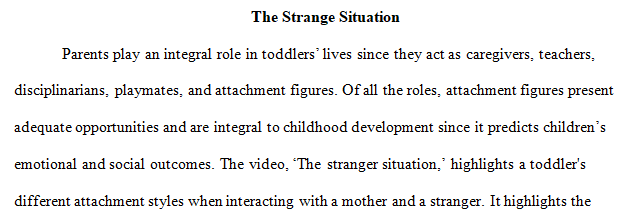Infants seek social bonds, which they develop with one or several people as long as the caregivers are responsive and familiar
Infants seek social bonds, which they develop with one or several people as long as the caregivers are responsive and familiar
“Infants seek social bonds, which they develop with one or several people as long as the caregivers are responsive and familiar. In the early months, synchrony begins: infants and caregiver interact face to face, making split-second adjustments in their emotional responses to each other. The still-face situation mentioned in the book reveals the importance of facial expression to infants.
Early responsiveness evolves into attachment, an emotional bond that encourages toddlers to explore. Secure attachment allows learning to progress; insecure infants are less confident and may develop emotional impairments. As infants become more curious and as they encounter new toys, people, and events, they use social referencing to learn whether such new things are fearsome or fun.
Although mothers are infants’ usual, and most social partners, the emotional connections evident in synchrony, attachment, and social referencing, can also occur with fathers, other relatives, and day-care providers. Instead of harming infants, as was once feared, non-maternal care can enhance infants’ psychosocial development”.
Mary Ainsworth developed an experimental procedure know as the Strange Situation. She did this to observe the variety of attachment forms that are exhibited between infants and their primary caregiver (for the purposes of this discussion I’m going to refer to the primary caregiver as the mother).
The Strange Situation demonstrates different attachment styles which are based on the interaction behaviors directed towards the mother when she returns to the room after leaving the infant alone with someone the infant does not know. There are 4 things that the researchers wanted to pay attention to when observing the baby’s behavior:
- Does the baby seek out the mother when she returns and want to be near her
- Does the baby maintain contact with the mother after she returns
- Does the baby avoid the mother and avoid contact with her
- Was the baby resistant to contact and comforting by the mother
In this video we will observe a baby’s response when the mother returns to the room. Pay attention to the child’s level of separation anxiety, her stranger anxiety, and her behavior when mom returns to the room. The child’s behavior will give us many clues about the level of attachment this child has with her mother.
Mary Ainsworth originally identified 3 types of attachment styles from her research, Secure attachment, Insecure Avoidant attachment, and Insecure ambivalent or resistant attachment. Several years later Disorganized attachment was added to the list.
Secure attachment—Secure children feel confident that their mother will be available to meet their needs. They use her as a safe base to explore the environment and seek her comfort in times of distress (Main, & Cassidy, 1988).
Insecure Avoidant—insecure avoidant children do not focus on their mother when exploring a new environment. They are very independent of mom, both physically and emotionally. They do not seek her out when distressed.
Insecure Ambivalent/Resistant—the infant has an ambivalent behavioral style towards their mother. They may have clingy and dependent behavior, but they might also reject the mother when she tries to interact with the infant.
Watch this Strange Situation Video Links to an external site. and post your thoughts on what you watched.
The Strange Situation – Mary AinsworthLinks to an external site. – https://www.youtube.com/watch?v=QTsewNrHUHU
Answer preview for the paper on ‘Infants seek social bonds, which they develop with one or several people as long as the caregivers are responsive and familiar’

APA 527 words
Click the purchase button below to download full answer…….
